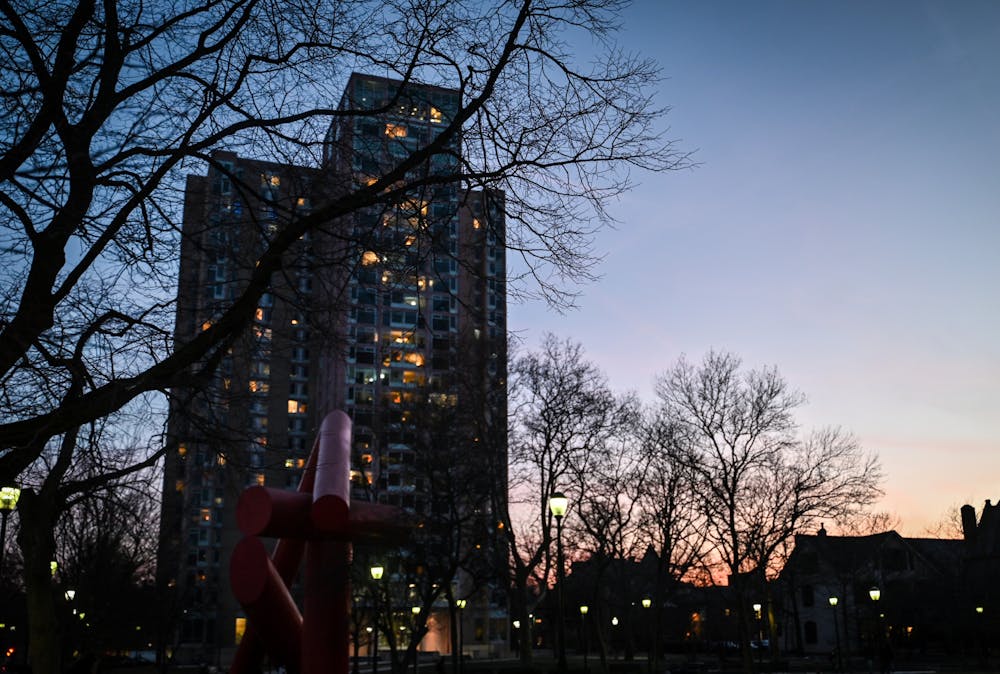
Over the nearly six decades that Penn has opened West Campus to student housing, the University’s infamous trifecta of high-rise buildings — Harnwell, Harrison, and Rodin College Houses — has managed to consistently fall short of many already-low expectations.
Perhaps the most obscene case yet was on display just a few weeks back. The closest elevator to my dorm, situated at the center of a hall that residents pass through on their way in and out of the floor, had a strapless bra plastered onto its doors.
Who had the audacity to pull this off, to air their personal drama — and lingerie — to the masses? That too, near the busy, camera-laden entrance of the hallway.
I was, unfortunately, not surprised. Penn isn’t a stranger to such stunts, especially during pledging season. More importantly, though, the attempted tour de force was just another notch on a list of grievances of temperature control problems, mold colonies, and faulty facilities in Penn's high rises.
My first visit to a high rise residence was last year, during a premiere screening of an indie horror film hosted by the Wharton Undergraduate Media Company. The film was average — I could see why major studios didn’t pick it up. But the venue, Harrison’s Sky Lounge on the 25th floor, was the saving grace of the evening. Floor-to-ceiling windows offered panoramic views of Philadelphia. The illuminated LED logos of the Penn Medicine Pavilion shone against the skyline were a stark contrast to the former cotton plantation I’d overlooked at my boarding school in South Carolina. At the time, I was optimistic about my future in the high-rises, and I only wish I could hold on to that optimism now as a high rise resident.
Within only two months of this academic year, Penn authorized up to $13.8 million for upgrades to elevators in Harrison and Harnwell College Houses, expected to be completed within the next two years. These plans, although promising, are set to take place following the graduations of the Class of 2026 and 2027 — but what do we make of the caution tape sealing off the elevators today? Meanwhile, in just the last semester, I received 12 emails concerning elevator outages, all of which concluded with: “We will pass more information on repairs when it is available … Residents may wish to leave additional time to get to appointments or class or consider using the stairs if possible.”
These stairs are winding flights that span 25 floors. Especially during rush hours, their concrete steps are a slip hazard. Safety shouldn’t hinge on our level of patience; and, patience runs thin when you’re waiting ten minutes for an elevator. Even then, waiting is a gamble: you might step into the elevator and find the remains of someone’s morning coffee on the floor.
I'm sure at least some of you will ask why I don't just leave my dorm. If I even vaguely considered studying abroad this year — Greece, the United Kingdom, Singapore, really anywhere, even if unrelated to my degree — it was to avoid mandatory campus housing. Beginning with the Class of 2024, all sophomores were required to live on campus. Additionally, those transferring to Penn must also live on campus for up to four semesters. As for where we live, students are assigned a randomized selection timeslot for the room selection period. During their time slot, students log into the housing portal to view available rooms and select their desired option in real time. To put it simply, these time slots determine the order in which students can choose their rooms. Earlier slots provide better access to preferred housing options, including singles and specific apartments. I was among the less fortunate assignees, those with later times who are stuck overpaying for whatever’s left.
Typically, the standard rate of $12,640 for the 2024-2025 academic year applies to all first-year student rooms and most upperclass rooms in specific College Houses. However, for the premium rate of $16,580, students are offered apartments with a living room and kitchen in high rise buildings. Unable to secure a standard-rate room, I was forced into a higher-rate apartment with a kitchen I have yet to use — and roaches as a bonus. Considering Penn's requirement for students to also remain on a dining plan during their first two years, the University has a captive market for its subpar services.
However, we’re not paying premium rates to just work around broken systems. We’re essentially required to engage with a system that seems to ignore our needs. And faulty infrastructure isn’t a privilege issue — it’s a safety one. Our residences aren’t short of maintenance staff and funding, but clearly, there’s a gap between effort and outcome. For now, Penn’s housing options don’t reflect the caliber of the institution they represent.
MRITIKA SENTHIL is a sophomore from Columbia, S.C. Her email is mritikas@upenn.edu.
The Daily Pennsylvanian is an independent, student-run newspaper. Please consider making a donation to support the coverage that shapes the University. Your generosity ensures a future of strong journalism at Penn.
Donate







